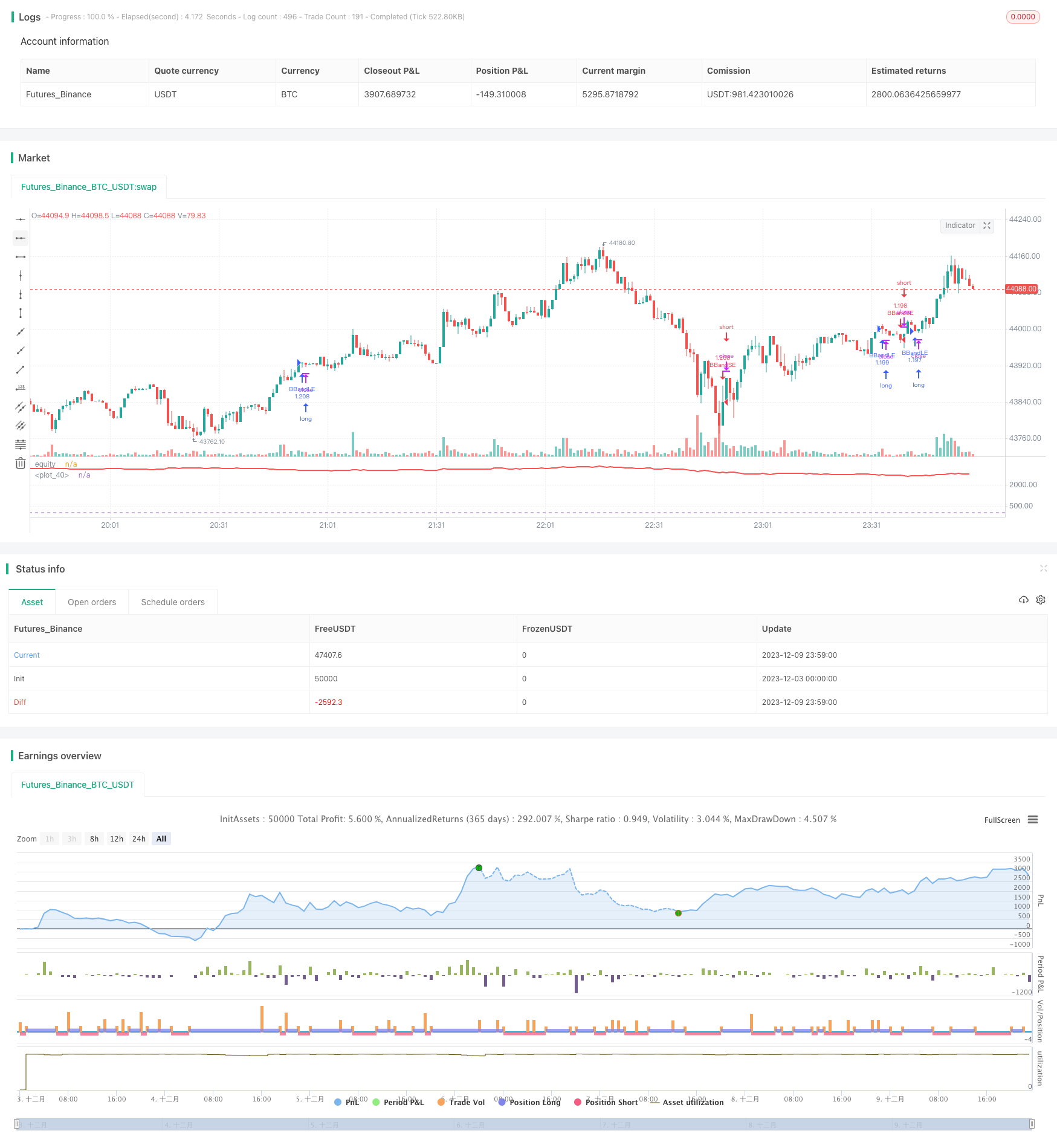
概述
该策略通过计算移动平均线和价格变化率,结合一定周期内的K线,判断目前处于上涨趋势还是下跌趋势,并相应做多或做空。
策略原理
该策略首先计算长度为l的简单移动平均线a和长度为l的价格变化率r。然后计算当前K线价格与移动平均线的差值k。最后计算k在过去s根K线的总和sum。
当sum>0时,表示目前处于上涨趋势,该策略会做多。当sum时,表示目前处于下跌趋势,该策略会做空。
做多做空后,会一直持有头寸,直到趋势发生逆转(sum从正变负或从负变正),这时就会平仓。
优势分析
该策略最大的优势是能够抓住趋势,适合趋势交易。具体来说,有以下几点优势:
使用移动平均线判断整体趋势方向,可以有效过滤市场噪音,锁定主要趋势。
应用价格变化率指标衡量动量强度,避免错过强劲行情。
考量一定周期内多个K线,可以更准确判断趋势,避免被 einzelne Ausreißer in die Irre führen。
只要趋势不变,就持续持有头寸,最大程度享受趋势行情带来的利润。
风险分析
该策略主要存在以下风险:
无法准确判断趋势结束时间,可能预早停损或错过部分利润。
无法有效控制单笔损失大小,极端行情下亏损可能较大。
策略参数不当可能导致过于频繁交易或漏掉部分交易机会。
长期持仓可能面临隔夜利息和保证金风险。
为控制风险,可以设置止损点、仅交易高流动性商品、优化参数以及合理使用杠杆。
优化方向
该策略主要可以从以下几个方面进行优化:
测试不同长度的移动平均线和价格变化率,找到最佳参数组合。
尝试其他指标如MACD等判断趋势,进一步提高准确率。
增加仓位管理机制,例如盈利后部分止盈等,控制单笔亏损。
结合波动率指标设定动态止损,降低极端行情的风险。
优化开仓和平仓逻辑,过滤假突破提高交易效率。
总结
该策略整体思路清晰、易于实现,通过跟踪趋势进行长线持仓交易,回撤控制相对合理,适合追求稳定收益的投资者。如能进一步优化止损和仓位管理等机制,可望获得较好的长期稳定回报。
/*backtest
start: 2023-12-03 00:00:00
end: 2023-12-10 00:00:00
period: 1m
basePeriod: 1m
exchanges: [{"eid":"Futures_Binance","currency":"BTC_USDT"}]
*/
//@version=2
strategy("Indicator Integrator Strat",default_qty_type = strategy.percent_of_equity, default_qty_value = 100,currency="USD",initial_capital=662, overlay=false)
l = input(defval=170,title="Length for indicator")
s = input(title="Length of summation",defval=18)
a= sma(close,l)
r=roc(close,l)
k=close-a
sum = 0
for i = 0 to s
sum := sum + k[i]
//plot(a,color=yellow,linewidth=2,transp=0)
//bc = iff( sum > 0, white, teal)
//plot(sum,color=bc, transp=20, linewidth=3,style=columns)
//plot(sma(sum,3),color=white)
//hline(0)
inpTakeProfit = input(defval = 0, title = "Take Profit", minval = 0)
inpStopLoss = input(defval = 0, title = "Stop Loss", minval = 0)
inpTrailStop = input(defval = 0, title = "Trailing Stop Loss", minval = 0)
inpTrailOffset = input(defval = 0, title = "Trailing Stop Loss Offset", minval = 0)
useTakeProfit = inpTakeProfit >= 1 ? inpTakeProfit : na
useStopLoss = inpStopLoss >= 1 ? inpStopLoss : na
useTrailStop = inpTrailStop >= 1 ? inpTrailStop : na
useTrailOffset = inpTrailOffset >= 1 ? inpTrailOffset : na
////buyEntry = crossover(source, lower)
////sellEntry = crossunder(source, upper)
if sum>0
strategy.entry("BBandLE", strategy.long, oca_name="BollingerBands", comment="BBandLE")
else
strategy.cancel(id="BBandLE")
if sum<0
strategy.entry("BBandSE", strategy.short, oca_name="BollingerBands", comment="BBandSE")
else
strategy.cancel(id="BBandSE")
strategy.initial_capital = 50000
plot(strategy.equity-strategy.initial_capital-strategy.closedtrades*.25/2, title="equity", color=red, linewidth=2)
hline(0)
//longCondition = sum>0
//exitlong = sum<0
//shortCondition = sum<0
//exitshort = sum>0
//strategy.entry(id = "Long", long=true, when = longCondition)
//strategy.close(id = "Long", when = exitlong)
//strategy.exit("Exit Long", from_entry = "Long", profit = useTakeProfit, loss = useStopLoss, trail_points = useTrailStop, trail_offset = useTrailOffset, when=exitlong)
//strategy.entry(id = "Short", long=false, when = shortCondition)
//strategy.close(id = "Short", when = exitshort)
//strategy.exit("Exit Short", from_entry = "Short", profit = useTakeProfit, loss = useStopLoss, trail_points = useTrailStop, trail_offset = useTrailOffset, when=exitshort)